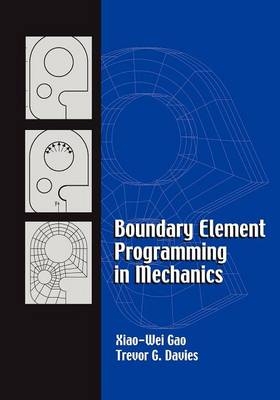
Boundary Element Programming in Mechanics
Seiten
2011
Cambridge University Press (Verlag)
978-1-107-40025-2 (ISBN)
Cambridge University Press (Verlag)
978-1-107-40025-2 (ISBN)
This 2002 book describes the numerical implementation of boundary element methods for nonlinear analysis in solid mechanics. Sufficient background information on nonlinear mechanics and boundary element techniques is provided to enable the reader to understand the method. A BEM source code is also available on the book's companion website.
Nonlinear stress analysis (a branch of solid mechanics) is an essential feature in the design of such diverse structures as aircraft, bridges, machines, and dams. Computational techniques have become vital tools in dealing with the complex, time-consuming problems associated with nonlinear stress analysis. Although finite element techniques are widely used, boundary element methods (BEM) offer a powerful alternative, especially in tackling problems of three-dimensional plasticity. This 2002 book describes the application of BEM in solid mechanics, beginning with basic theory and then explaining the numerical implementation of BEM in nonlinear stress analysis. The authors have also developed a BEM source code for use by the reader, which is available on the book's companion website. This book will be especially useful to stress analysts in industry, research workers in the field of computational plasticity, and postgraduate students taking courses in engineering mechanics.
Nonlinear stress analysis (a branch of solid mechanics) is an essential feature in the design of such diverse structures as aircraft, bridges, machines, and dams. Computational techniques have become vital tools in dealing with the complex, time-consuming problems associated with nonlinear stress analysis. Although finite element techniques are widely used, boundary element methods (BEM) offer a powerful alternative, especially in tackling problems of three-dimensional plasticity. This 2002 book describes the application of BEM in solid mechanics, beginning with basic theory and then explaining the numerical implementation of BEM in nonlinear stress analysis. The authors have also developed a BEM source code for use by the reader, which is available on the book's companion website. This book will be especially useful to stress analysts in industry, research workers in the field of computational plasticity, and postgraduate students taking courses in engineering mechanics.
Preface; Part I. Linear Problems: 1. Introduction; 2. Theory of elasticity; 3. Boundary integral equations for elasticity; 4. Numerical implementation; 5. The elastic program code; 6. Linear applications; Part II. Non-Linear Problems: 7. Rate-independent plasticity theory; 8. Boundary integral equations in elasto-plasticity; 9. Numerical implementation; 10. The elasto-plastic program code; 11. Non-linear applications; 12. Epilogue; Appendices: A. Derivation of the kernel functions; B. Shape functions; C. Degenerate elements; D. Elasto-plastic flow theory; E. Domain integral formulations; F. Solution of non-linear system equations; G. Elements of elasto-plasticity; H. Description of input data.
| Erscheint lt. Verlag | 21.7.2011 |
|---|---|
| Zusatzinfo | Worked examples or Exercises |
| Verlagsort | Cambridge |
| Sprache | englisch |
| Maße | 178 x 254 mm |
| Gewicht | 480 g |
| Themenwelt | Mathematik / Informatik ► Mathematik ► Angewandte Mathematik |
| Technik ► Bauwesen | |
| Technik ► Fahrzeugbau / Schiffbau | |
| Technik ► Luft- / Raumfahrttechnik | |
| Technik ► Maschinenbau | |
| ISBN-10 | 1-107-40025-2 / 1107400252 |
| ISBN-13 | 978-1-107-40025-2 / 9781107400252 |
| Zustand | Neuware |
| Informationen gemäß Produktsicherheitsverordnung (GPSR) | |
| Haben Sie eine Frage zum Produkt? |
Mehr entdecken
aus dem Bereich
aus dem Bereich
Buch | Softcover (2024)
Springer Vieweg (Verlag)
37,99 €
Buch | Softcover (2024)
Springer Vieweg (Verlag)
44,99 €


